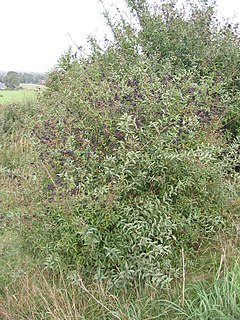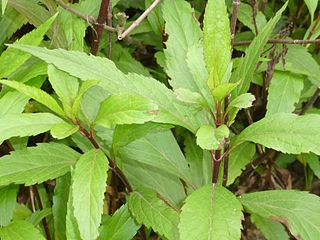
Eurybia is a genus of plants in the composite family that were previously included in the genus Aster. Most species are native to North America, although one is also present in northern Eurasia. There are 23 species in the genus, including 1 natural hybrid. The name was first applied by Alexandre de Cassini in 1820. The name is derived from Ancient Greek εὐρύς (eurús), meaning "wide", and βαιός (baiós), meaning "few", perhaps in reference to the small number of relatively wide ray florets.

Ligustrum vulgare is a species of Ligustrum native to central and southern Europe, north Africa and southwestern Asia, from Ireland and southwestern Sweden south to Morocco, and east to Poland and northwestern Iran.

Calochortus albus is a species in the genus Calochortus in the family Liliaceae. It is also known by the common names fairy lantern, white fairy lantern, pink fairy lantern, lantern of the fairies, globe lily, white globe lily, white globe-tulip, alabaster tulip, Indian bells,satin bells, snowy lily-bell, and snow drops.

Brunfelsia pauciflora is a species of flowering plant in the family Solanaceae, the nightshades. It is endemic to Brazil, and it is grown in cultivation. A shrubby perennial plant grown in gardens, its common names include yesterday-today-and-tomorrow, morning-noon-and-night, Kiss Me Quick, and Brazil raintree.

Eupatorium fortunei is a plant species in the family Asteraceae native from Asia where it is rare in the wild but commonly cultivated. The white to reddish colored flowers and herbage smell like lavender when crushed. In China the plants are used to make fragrant oils.

Papaver lateritium, the Armenian poppy, is a species of poppy endemic to Armenian Highlands, Georgia and North Eastern Turkey.
Meconopsis bella is commonly known as the pretty blue poppy. M. bella is a species of the genus Meconopsis which is found from central Nepal to southeastern Tibet. It is a herbaceous flowering plant and is a part of the poppy family Papaveraceae. This plant is also referred to as Meconopsis bella prain, since it was aptly names by the botanist Prain.

Meconopsis horridula, the prickly blue poppy, is a flowering plant from the family Papaveraceae. It is an endangered species that grows in high altitudes. The height of the plant varies from 20 cm to 1m. It is a monocarpic, dicot plant.
Lepidium nesophilum is a flowering plant in the mustard and cabbage family. The specific epithet is derived from the Greek nesos (“island”) and -philus (“loving”), alluding to its island home.

Iris wilsonii is a species in the genus Iris, also the subgenus Limniris and in the series Sibiricae. It is a rhizomatous herbaceous perennial, from China. It has long and drooping grey-green leaves, hollow stems and 2 fragrant yellow, pale yellow or yellow/white flowers.
Iris anguifuga is a beardless iris in the genus Iris, in the subgenus Limniris and in the series Tenuifoliae of the genus. It is a rhizomatous herbaceous perennial, from China. It has narrow green leaves, long stem and violet or blue flowers.
Iris cathayensis is a beardless iris in the genus Iris, in the subgenus Limniris and in the series Tenuifoliae of the genus. It is a rhizomatous herbaceous perennial, from China. It has grey-green leaves, short stems and violet flowers.
Iris kobayashii is a beardless iris in the genus Iris, in the subgenus Limniris and in the series Tenuifoliae of the genus. It is a rhizomatous herbaceous perennial, from China. It has slightly twisted leaves, short stems and 1 to 2 purple or blue and yellow flowers.
Iris qinghainica is a beardless iris in the genus Iris, in the subgenus Limniris and in the series Tenuifoliae of the genus. It is a rhizomatous herbaceous perennial, from China. It has grey green leaves, a very short stem and 1–2 blue or violet flowers.
Iris farreri is a beardless iris in the genus Iris, in the subgenus Limniris and in the series Tenuifoliae of the genus. It is a rhizomatous herbaceous perennial, from China. It has grey-green leaves, long stem and 1 or 2 violet, lilac or light blue flowers. It has undergone several changes of name and series, before being left as Iris farreri.
Syringa pinetorum is a species in the genus Syringa, in the family Oleaceae.

Syringa tomentella is a species in the genus Syringa, in the family Oleaceae.
Iris curvifolia is a plant species in the genus Iris, it is also in the subgenus of Iris, and in the Psammiris section. It is a rhizomatous perennial, from China. It has sickle-shaped long leaves, short stem and yellow or bright yellow flowers. It is cultivated as an ornamental plant in temperate regions.
Iris heweri is a plant species in the genus Iris, it is also in the subgenus Iris and in the section Regelia. It is a rhizomatous perennial, from Afghanistan. It has tall, green curved leaves, tall slender stems and purple blue or violet-blue flowers, with white and purple or lilac beard. It is cultivated as an ornamental plant in temperate regions.
Hypericum acmosepalum is a dwarf shrub in Hypericumsect. Ascyreia that is native to China and known as jian e jin si tao locally.








